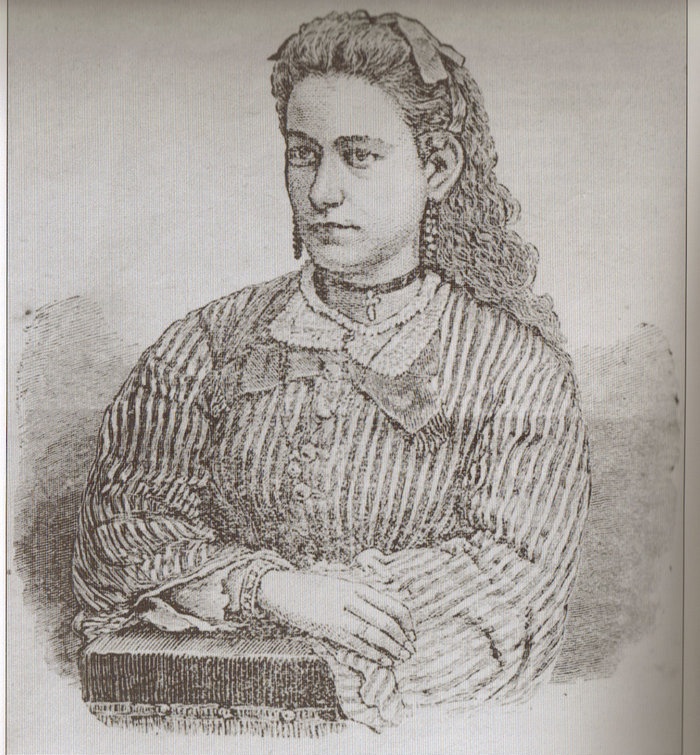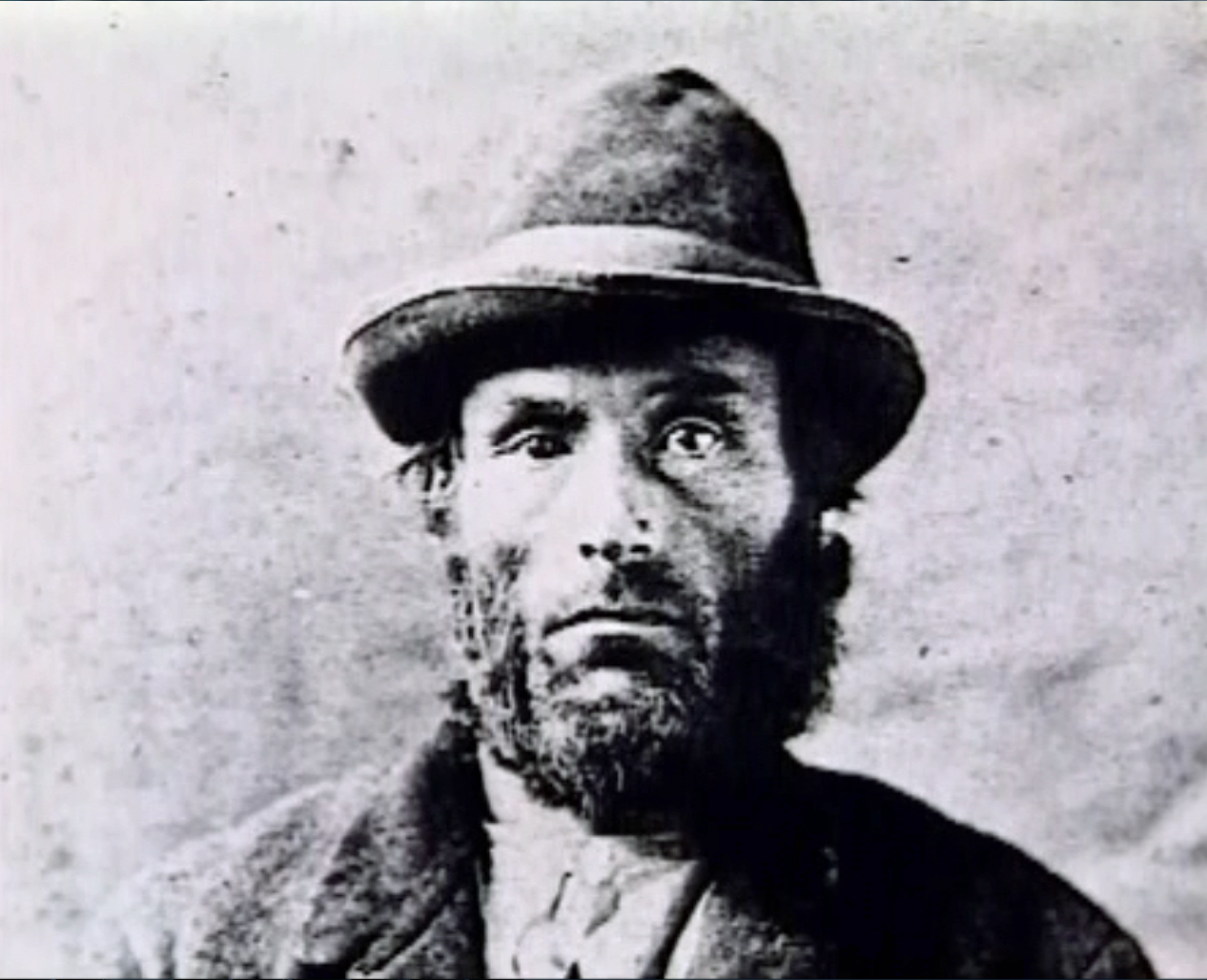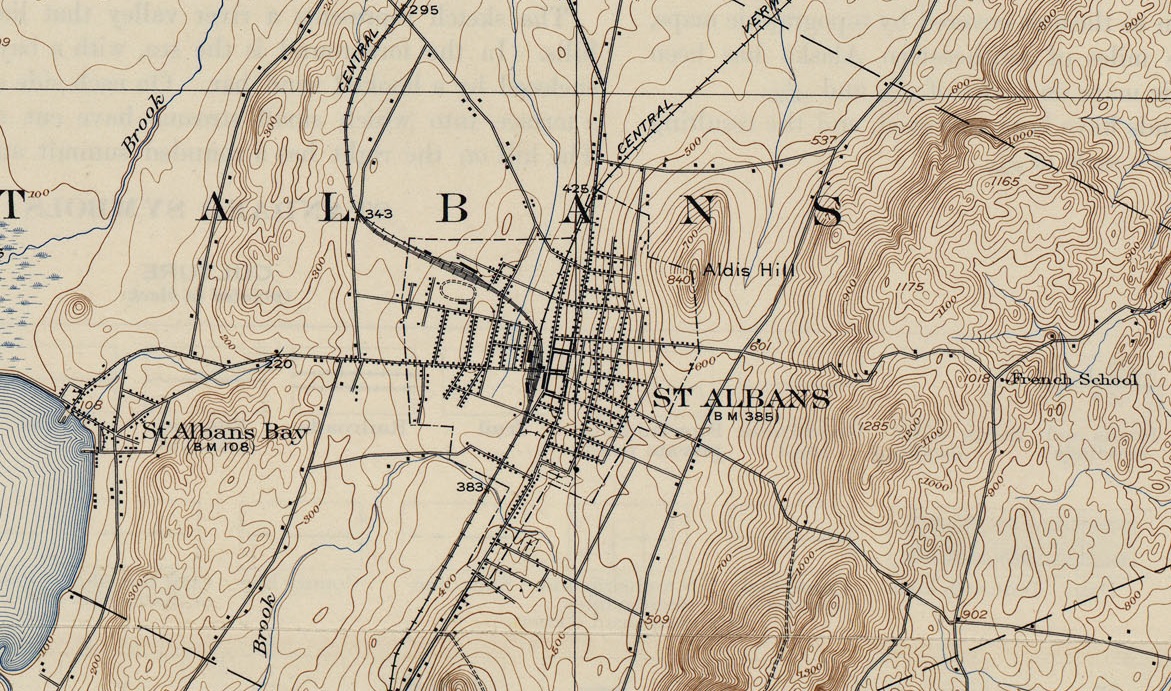St Albans, Vermont, 1874. It seems that the summer brought more to town than sultry weather. The entire town was coping with a string of random and violent acts that were plaguing everyone’s peace of mind. A series of unsolved burglaries had the business community on edge, as well as a mysterious assault on a local physician who couldn’t identify his attackers. Later, a French Canadian man was killed in a stabbing incident, his attacker or attackers faded into the summer heat.
And then, on July 24th, something happened that finally caused the Railroad City to come apart at the seams.
20 year old Marietta Ball had just been hired for a teaching position at a rural schoolhouse on French Hill during the summer months. She was described as a tall and slender young woman who was intelligent and kind hearted. She had blue eyes, light brown hair and weighed 130 pounds. Because she was a spinster, she didn’t mind the work or her rural location. French Hill, being a steep and remote hill area located east of the city, involved a steep climb up the west slope before dropping behind a ridge line to get to the schoolhouse. Even today, French Hill Road is steep and challenging, and in the winter it’s a white knuckle, break riding accent down to the safety of Route 104 below.
Marietta had arranged for room and board with a neighboring farm family, The Abels. After she would be finished at the schoolhouse, she would walk a lonely road that ran south from the schoolhouse just underneath the crest of the hill to get there. On the weekends however, she would stay with the Page family whose house stood at the very south end of the road, at the junction of today’s Vermont Route 36. But on that warm July evening, she would never reach her destination.
After much time had elapsed and Marietta hadn’t arrived, the Pages began to worry. Towards the evening, Mrs. Page’s concern got the best of her, and she began walking up the road to the nearby Collins residence to see if they had possibly seen her. As she walked up into the hills, the night air began to cool down and the sunset was burning with fiery vengeance. The Collins however were just as surprised that Marietta hadn’t shown up, and by 10 P.M., a search party was assembled.

Not long after setting out, the party’s lantern lights soon found what appeared to be the sight of an ambush in a nearby hollow. Near the site of the ambush was their first clue hinting that something sinister had taken place here; a makeshift mask that had been made from a piece of torn carpeting. Around 1 A.M., Frank Harris, a black man who was employed by Mr. Page, began shouting that he found a body. Through the haze of the lanterns keeping the wild shadows at bay, the gruesome remains of Marietta Ball began to take form.
Upon first assumptions, the party agreed that she had been sexually assaulted. But a later post mortem was conducted during daylight hours by a St. Albans physician named Dr. Fassett and a visiting New York physician, Dr. Janeway. Now they understood exactly what had happened. They noticed that her assailant had wrapped her head in her overskirt, which was a bit peculiar. Once that was removed, her brutal wounds were revealed. She had been savagely beaten to death. Her attacker must have had a moment of reconsideration, and made a clumsy attempt at hiding what he had done. They noted that her limbs were also re-positioned in an attempt to deceive whoever found her.

The town was outraged and their thirst for blood was ignited. Not long after Marietta’s body was found, the first of what would become several arrests were made. Frank Harris would be the first one taken into custody. A neighbor of the Page’s, Mrs Drinkwine, claimed that she left behind a fragment of the same carpet that was found at the crime scene in a rental house she owned. As it turned out, Mr. Harris was living in the house at the time of the murder, and Mrs. Drinkwine thought that was evidence. She insisted that she could prove the carpet was from the house by providing a sample of the same carpet in her own home, but her son became the voice of reason and told her that she shouldn’t make any accusations unless she knew they were true. Embarrassed, she dropped the matter and Frank Harris was released from custody with no grounds to hold him.
On July 27th, a search party was organized to search the area of the murder, in an attempt to find more evidence. Various items were soon discovered that belonged to her, including a ribbon from her hair and her damaged watch. The face of the watch had been smashed, it ceasing to function around 4:20. The search party assumed that was probably her time of death. Further investigation finally uncovered a rather large stone that had dried blood glazing its surface – they had found the murder weapon. But the frustrated party returned home with no evidence that could apprehend anyone.
Marietta’s funeral was also held on the 27th as the search party combed the slopes and marshlands of French Hill.
After Harris’s release from custody, a second suspect was immediately brought in, a former French Canadian student of Miss Ball’s named Revoir. It was known that he had been punished and removed from the school by her after an issue of conflict had taken place, which made him a suspicious character with a motive. But he also didn’t have enough evidence to be convicted, and was later released.
To add to escalating tensions and paranoia, rumors began to spread about an organized gang with sinister intentions who were hiding out in a swampy and inaccessible region of Fairfield known as Cedar Swamp. Some even blamed them for all of the burglaries and the assault on the local physician that happened before Marietta’s murder. Even today, the Cedar Swamp region of Fairfield is a mysteriously beautiful and remote location that remains almost as wild as it probably did then.
Soon, anyone who was labeled as suspicious by the ever growing tense population were detained and brought in for questioning. But because of a popular dislike at the time of “outsiders” (the lower classes, traveling beggars and minority populations), they sadly were most oftentimes the targets of suspicion and often found themselves in the wrong place at the wrong time. The local papers, desperate for updates on the story, printed anything they could regardless of factual information.
Now, rumor began to replace fact. Mrs. Page seemed to recall a strange man who was seen around the schoolhouse during the week before the murder, which helped aid the growing fear.
Another story accused an Irish engineer from The Vermont Central Railroad of being guilty, because a year ago he admitted he had feelings for Miss Ball but it was said that she rejected him. He didn’t take the rejection well and said some harsh words as a response, something about revenge or getting even. But upon further investigation, it was discovered that he was actually in his home at the time of the murder, and once again, the case was right back to where it began.
In a more bizarre case, a clairvoyant named “Sleeping Lucy” gave authorities a description of a man who she claimed to be the murderer, – the image of a man who came to her in a vision. Going by her description, they were actually able to find this gentleman, and he was arrested and interrogated. But despite admitting to knowing Miss Ball, by August 3rd, they had no grounds to hold him, and he was released.
By August 14th, St. Albans seemed to be in the clutches of obsession. The murder wasn’t fading into memory, it was a wildfire burning. There had already been several arrests and no convictions. Until now, the immigrant populations and the minority groups had been targeted, (Harris who was black, Revoir who was French and the train engineer who was Irish, etc) but that cup was full, and now the more esteemed members of St. Albans society began to be suspected.
The first to be suspected was the eldest son of ex-Governor Smith, George Gregory Smith. But it would be a full year before he would be be questioned, and that was only because of mounting public pressure for him to do so. And before his hearing, he openly challenged anyone who suspected him to show up and state their claim.
Others were accused as well. Friends turned on friends. If you were reported to even being in the vicinity of French Hill near the time of the murder, someone would mention your name to the police. Several people were brought in just for riding in their carriages down the hill into town. Someone else was supposedly suspected because she wore the same earrings as Miss Ball did.
Refusing to give way to the triumph of their enemies, more measures were taken. On June 25th, 1875, a group of citizens formed “The Union Investigation Society” to further embark down the long, dark road of the murder case. Among those who joined were Mr. Page and Mr. Collins. The group would then be divided into smaller groups who would be assigned to search certain districts of town.
Soon, another puzzling piece of information was unveiled. Georgia resident Eleazer Jewitt claimed that Marietta’s father, George Ball, had once told him that he knew that George Smith was the one who killed his daughter. But shortly after, Mr. Ball had reportedly gained a considerable amount of money and immediately left town for California. But before he left, he changed his story, and insisted that Frank Harris had killed her. So, did George Smith pay Mr. Ball for his silence? A further investigation revealed that the money Mr. Ball had received was only $200, sent from his sons in California to pay for his trip there so he could live with them. An officer of the local bank assisted in his defense, and said that Mr. Ball had been in serious debt and did not inherit any amounts of money. To further prove this, a trip to his small farmhouse revealed all of his furniture to be cheap and purchased at various auctions. So Mr. Smith and Mr. Ball were both acquitted of their accusations.
Another curious piece of evidence came shortly after, a blood soaked handkerchief was found near the murder scene with the name “G.J. Ingram” monogrammed in it. But the police were at a loss. After an extensive search, no person with the name Ingram was found to be existing in the area.
After over a years worth of investigating and community outcry, the murder of Marietta Ball seemed to be as mysterious as when it first started. Many were accused, neighbors turned against each other and the community was easily a whole lot worse for wear. It seemed like the secrets would forever be lost to the cold ground of French Hill, the light of the moon masquerading those things that we’d never know.
But on October 14th, 1875, a shocking discovery was made. A French Canadian named Joseph LaPage was convicted of brutally murdering Josie Langmaid of Suncook, New Hampshire. And someone made a strange note that the way Josie was murdered was almost exactly the same as Marietta Ball’s murder. News traveled back to St. Albans and Mr. W.N. Abel of The St Albans Messanger recalled Joseph LaPage living in the French Hill area at the time of the murder. He contacted Justice Farnsworth of St. Albans, who immediately contacted officials in Suncook. LaPage had just became the latest suspect in the murder of Miss Ball.

On January 13th, 1876, Joseph LaPage was sentenced to appear in court, and was found guilty for both murders. On March 15th, he was sent to the gallows in Concord, New Hampshire. It was said that he loudly claimed his innocence from when he was first accused until just hours before he was hanged, when he choked out a sobbing confession. It seems the skeletons he was hiding finally found him.
But some questions remain. Why was Mr. Ball so determined to accuse George Smith of murder? What suspicions induced the community to suspect him to begin with? And who was G.J. Ingram? And there are some who argue that the evidence that linked Joseph LaPage to the murders wasn’t enough to convict him. So, if this is the case, did they hang the wrong person? Perhaps only the good night knows these answers as the softness of the summer attempts to sooth the community’s scars.
But this tragic tale has another ending. I was also told that Joseph LaPage was finally caught when his son, who somehow discovered his dark past, made his way to St. Albans and reported him to local authorities. But there doesn’t seem to be any record of this, making me believe this is the product of the re-shaping of a story as it travels through the years.
French Hill Today
Until recently, a friend of mine owned a beautiful piece of property on French Hill, comprised of mix woodlands and a vast beaver pond which, on summer nights, was a strikingly beautiful place to sit by under the songs of the cicadas, and she was the one who turned me onto this intriguing story and compelled me to research it.
She had no information about the murder until one day, an actual descendant of Marietta Ball stopped by her house, and asked permission to look around the property. Confused, she asked why, and the man filled her in on the story. He said he was looking for the place where Marietta’s body was found. But he also had a theory that Joseph LaPage’s house may have actually stood on the property as well, and was in hopes of finding the old foundation. Though the man couldn’t be certain, he assumed that after Marietta had been murdered, Joseph crossed a brook that ran through the property and went back to his house. But sadly, I’ll never know if he found what he was looking for.
But this was an interesting turn of events, because before that chance encounter, my friend swore her house was haunted. By what, she wasn’t certain. But both her and members of her family swore they felt uncomfortable in certain rooms of the house, and the stairway leading to the second floor. Feelings of being watched by some sort of dark entity were reported often. Now it seems a connection could be made. Was it in fact the ghost of Joseph LaPage who was haunting their house? Did he seek refuge on the wilds of French Hill in his afterlife? Or maybe, these uncomfortable feelings can be attributed to something else?
Another strange footnote to the story; Marietta Ball was buried in St Albans’ Greenwood Cemetery, and was given an elaborate headstone which was much nicer than most of the graves in the cemetery. But years of neglect and weather erosion have made the kind gesture into something sad and fading. Her grave site is also the only grave in the entire cemetery that faces East. I’ve heard a theory that it’s position was done deliberately, so it would be facing French Hill which arcs above the tree tops in the distance. Or maybe, it was a simple mistake?
So what lessons can we learn from this story? And will we remember them? I think its sad to say that the outcomes that were inspired by Marietta’s murder are very similar to what would happen even today. And when we rely on the justice system to handle such matters, can we honestly say that justice is really being served at times? Or will these things be obscured by the solemn sounds of sirens wailing in the dark woods?

Links and sources: For a much more detailed look into the murder than what I have provided:
As it turns out, someone has written a good write up about the Suncook Murders
The Trial of Joseph LaPage, The French Monster, Philadelphia, 1876.
The very detailed write up “The East Hill Murders”, Ronald C. Murphy, 1983
—————————————————————————————————————————————–
To all of my amazing fans and supporters, I am truly grateful and humbled by all of the support and donations through out the years that have kept Obscure Vermont up and running.
As you all know I spend countless hours researching, writing, and traveling to produce and sustain this blog. Obscure Vermont is funded entirely on generous donations that you the wonderful viewers and supporters have made. Expenses range from internet fees to host the blog, to investing in research materials, to traveling expenses. Also, donations help keep me current with my photography gear, computer, and computer software so that I can deliver the best quality possible.
If you value, appreciate, and enjoy reading about my adventures please consider making a donation to my new Gofundme account or Paypal. Any donation would not only be greatly appreciated and help keep this blog going, it would also keep me doing what I love. Thank you!
Gofundme: https://www.gofundme.com/b5jp97d4


